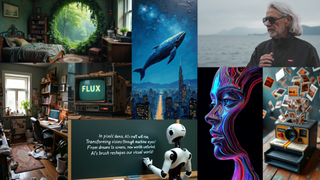A major new Midjourney rival has landed – here’s how to try the open-source Flux
AI image generation made easy

A new AI image generator named Flux.1 has burst onto the scene and is rapidly accruing kudos for its high-end results and the fact that it's an open-source model. Flux was built by Black Forest Labs, whose founders were previously at Stability AI, the creator of the popular Stable Diffusion line of AI image models.
Some are calling the Flux stable of models the successor to Stable Diffusion and possibly a major game-changer for accessible, high-quality generative AI tools.
There are three versions of Flux.1: Pro, Dev, and Schnell, in decreasing order of size. The Pro version is designed for commercial use, with companies already incorporating it to offer generative AI image services to their subscribers. The Dev and Schnell versions are optimized for different levels of performance and speed.
What sets Flux apart from Midjourney, Stable Diffusion, and many of its competitors? Most notably, the two smaller models can run on reasonably good hardware, such as high-performance laptops. This makes it more accessible to a broader range of users, including hobbyists, developers, and small businesses who may not have the resources to invest in more expensive, proprietary tools. It also means you don't have to rely on internet access or cloud storage to run Flux. And, while Midjourney has been praised for its ability to create highly detailed and visually appealing images, Flux claims to offer some distinct advantages, particularly in rendering human figures. Black Forest Labs is now working on adding a text-to-video model to its portfolio.
"Deeply rooted in the generative AI research community, our mission is to develop and advance state-of-the-art generative deep learning models for media such as images and videos, and to push the boundaries of creativity, efficiency and diversity. We believe that generative AI will be a fundamental building block of all future technologies," Black Forest Labs explained in its blog. "By making our models available to a wide audience, we want to bring its benefits to everyone, educate the public and enhance trust in the safety of these models. We are determined to build the industry standard for generative media."
We are excited to announce the launch of Black Forest Labs. Our mission is to develop and advance state-of-the-art generative deep learning models for media and to push the boundaries of creativity, efficiency and diversity. pic.twitter.com/ilcWvJgmsXAugust 1, 2024
How to get and use Flux
For those interested in exploring Flux, there are several ways to access and use the model. If your computer is good enough, you can download and run Flux.1 locally. Plus, Flux is an open-source model and compatible with multi-model platforms, which expands its availability significantly.
AI image platform NightCafe has already integrated the Flux.1 model, allowing users to compare its outputs directly with those from other models like Ideogram and Stable Diffusion 3.
Get the best Black Friday deals direct to your inbox, plus news, reviews, and more.
Sign up to be the first to know about unmissable Black Friday deals on top tech, plus get all your favorite TechRadar content.
Similarly, Poe offers a chatbot-style interface for generating images using Flux.1. For those a little more technical, you can also access Flux.1 through Hugging Face and other hubs of open-source AI models.
You might also like

Eric Hal Schwartz is a freelance writer for TechRadar with more than 15 years of experience covering the intersection of the world and technology. For the last five years, he served as head writer for Voicebot.ai and was on the leading edge of reporting on generative AI and large language models. He's since become an expert on the products of generative AI models, such as OpenAI’s ChatGPT, Anthropic’s Claude, Google Gemini, and every other synthetic media tool. His experience runs the gamut of media, including print, digital, broadcast, and live events. Now, he's continuing to tell the stories people want and need to hear about the rapidly evolving AI space and its impact on their lives. Eric is based in New York City.